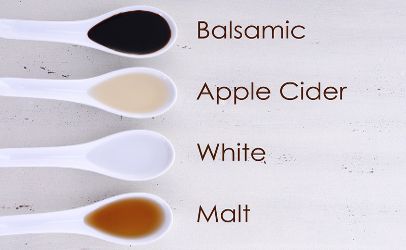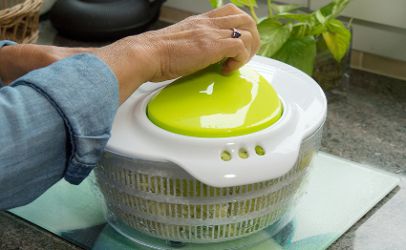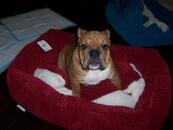- May 2, 2013
- 13,637
- 2,026
- Country
- U.S.A.
- Bulldog(s) Names
- Maudee,MarthaKatie,Lizzie,Bro.Mini
Before treating your lettuce or other fresh greens, remove broken or bruised leaves. The breaks enable pathogens to enter the cells and thus, become protected from the lethal effect of the vinegar or whatever antimicrobial you use. Additionally, the liquid from broken or bruised leaves aids the multiplication of both good and bad bacteria associated with the produce (Takeuchi & Frank 2000, Brandl 2008).
 Washing the leaves may reduce any unattached bacteria but has a poor effect on removing attached bacteria. There are many ways to sanitize or disinfect salad greens. Irradiation, cold plasma, electrolyzed water, and chlorine come to mind. But these are not readily available in most home kitchens. Thus, the purpose of this article: To review current science and offer practical recommendations to improve the safety of salads.
Washing the leaves may reduce any unattached bacteria but has a poor effect on removing attached bacteria. There are many ways to sanitize or disinfect salad greens. Irradiation, cold plasma, electrolyzed water, and chlorine come to mind. But these are not readily available in most home kitchens. Thus, the purpose of this article: To review current science and offer practical recommendations to improve the safety of salads.
Second:
Spoiler alert, vinegar kills pathogenic bacteria. Fans of the Law of Mass Action, will be happy that vinegar’s lethal effect is dependent on time, temperature, and the concentration of acetic acid (usually 6%). Balsamic vinegar, with its additional phenols is the cat’s pajamas of lethality.
Third:
There’s plenty of science on the effect of vinegar.
Entani et alia 1998, was a Japanese team concerned about a 1996 outbreak of Escherichia coli O157:H7. They wrote, “Vinegar had a bactericidal effect on food-borne pathogenic bacteria including EHEC 0157:H7.” They tested the vinegars on the surface of nutrient agar, not lettuce.
“Among three kinds of vinegar solutions, vinegar stock solution (acetic acid concentration 10%), a twofold dilution (5% acetic acid) and a fourfold dilution (acetic acid concentration 2.5%), the time necessary for inactivation of EHEC 0157:H7 NGY-lO at 30°C was 1 min, 25 min, and 150 min, respectively (measured as the time required to decrease colony forming units from 2.0 x 10[SUP]6[/SUP] CFU/ml to <2.0 x 10[SUP]1[/SUP] CFU/ml).”
Wu et alia 2000, at the University of Georgia and the Centers for Disease Control and Prevention, prompted by a 1998 shigellosis outbreak, treated parsley. The parsley, either chopped or whole was inoculated with three strains of Shigella sonnei. The treatments were straight vinegar, diluted vinegar or Na hypochlorite 0 to 200 ppm free chlorine for 5 min at 4°C or 21°C. Undiluted vinegar (5.2% or 7.6%) or > 150 ppm Cl reduced the S. sonnei population on whole leaves by over 6 Log[SUB]10[/SUB].
Vijayakumar and Wolf-Hall 2002, tested three organic acids and diluted bleach on iceberg lettuce leaves in flasks at room temperature and at 4°C. “Diluted solutions of various household sanitizers (apple cider vinegar , white vinegar , bleach, and a reconstituted lemon juice product) . . . 35% white vinegar (1.9% acetic acid) was the most effective in reducing E. coli levels (with a 5-log 10 reduction after 5 min with agitation and after 10 min without agitation),” they wrote.
Chang and Fang 2007, from the Department of Health, Taiwan, treated shredded iceberg lettuce with full strength rice vinegar (5% acetic acid) and dilutions on E. coli O157:H7. Five minutes at 25°C yielded a 3 Log[SUB]10[/SUB] reduction. Diluted vinegar containing 0%, 0.05%, or 0.5% acetic acid had no effect in eliminating E. coli O157:H7.
Yang et alia 2009, at Colorado State University, tested several household chemicals in suspensions against Listeria monocytogenes, E. coli O157:H7, and Salmonella Typhimurium. “The efficacies of household compounds against pathogens decreased in the following order: 0.0314% sodium hypochlorite > 3% hydrogen peroxide > undiluted vinegar and 5% acetic acid > 5% citric acid > baking soda (50% sodium bicarbonate). The sensitivity of the tested pathogens to all tested household compounds followed the sequence of Salmonella Typhimurium > E. coli O157: H7 > L. monocytogenes.”
Faith et alia 2012, used cocktails of either Salmonella sp. or L. monocytogenes on intact spinach leaves. The commercial vinegars were: rice vinegar, distilled white vinegar, white wine vinegar, apple cider vinegar, red wine vinegar, and balsamic vinegar with a commercial 100% natural canola oil. The spinach was treated in a Whirl-Pak bag by adding 20 ml of vinegar (diluted 50% with either water or oil) and held at room temperature for 30 minutes. The vinegars reduced the resident microbiota, primarily Gram -, about 3 logs[SUB]10[/SUB]. For the pathogen trials, they diluted the vinegar 1:2 with oil. Traditionally, a vinaigrette consists of 3 parts oil and 1 part vinegar.
The authors wrote, “Allowing the mixture to sit at room temperature for at least 20 min resulted in a substantial reduction (up to 2.0 log CFU) in numbers of S. enterica. Vinegar and oil caused a limited reduction in CFU (0.5 log) for spinach leaves inoculated with a cocktail of Listeria monocytogenes strains.”
Sirsat and Neal 2013, promoted Aquaponics over soil grown lettuce. They tested undiluted white vinegar, apple cider vinegar, red wine vinegar and lemon juice. Adding Salmonella or E. coli cocktails to undiluted vinegar or juice showed white vinegar was the most lethal. Treating inoculated lettuce with straight or diluted white vinegar (5% or 2.5% acetic acid) for 60 seconds resulted in a 2-3 Log[SUB]10[/SUB] reduction of Salmonella, E. coli, and coliforms. Their paper is open access so you can look at their Fig 3.
Ramos et alia 2014, used L. monocytogenes on iceberg lettuce. Rice, fruit, white, red wine, cider and balsamic vinegar were tested with the agar diffusion method. Balsamic vinegar was superior. The treatment solutions were: balsamic vinegar, white vinegar, and acetic acid diluted to 5.87%. The balsamic vinegar was also 5.87% acetic acid and the white vinegar 6.15%. These solutions were further diluted by 15, 20, 37 and 50% (v/v). The inoculated lettuce (~50 g) was added to one liter of a diluted vinegar for 15 minutes at room temperature, then removed and placed on sterile absorbent paper. All trials were in triplicate.
The results show that balsamic vinegar produced the greatest reduction except when diluted by 15% where white vinegar was better (0.9 Log[SUB]10[/SUB] vs 0.9 Log[SUB]10[/SUB]). The greatest reductions were with the 50% vinegar dilutions.
The authors wrote, “The maximum observed log reduction of L. monocytogenes was 2.15 ± 0.04 for balsamic vinegar (50% (v/v)), 1.18 ± 0.06 for white wine vinegar ((50% (v/v)) and 1.13 ± 0.06 for acetic acid ((50% (v/v)). Washing with water only reduces 0.05 ± 0.04 log CFU/mL of L. monocytogenes numbers.” The authors citing previous papers opined that, “The stronger bactericidal effect of balsamic vinegar may be also related to the presence of compounds with antimicrobial properties resulting from the fermentation of grape juice and from grape juice itself. It is known that grapes contain a number of phenolic compounds that exhibit antilisterial activity, particularly polymeric phenolic compounds: resveratrol, vanillic acid, caffeic acid, gallic acid and flavonoids (rutin and quercetin)”
Poimenidou et alia 2016, treated cut strips of romaine lettuce or spinach by washing with several solutions. The solutions were: water, a distilled aqueous extract of oregano, Na hypochlorite (60 and 300 ppm free chlorine), Citrox® (0.5%), vinegar (6% acetic acid), 2% lactic acid, and double combinations of Citrox, lactic acid and oregano. The treatment was immersing 310g of inoculated leaves in two liters of solution for either 2 or 5 minutes at room temperature. After treatment, half of the leaves were rinsed in ice water. All trials were repeated twice in triplicate. They measured both E. coli O157:H7 and the resident microbiota.
“For each treatment, samples of 20 g each were analyzed: (i) before treatment to estimate the attached population; (ii) after treatment, to assess the immediate antimicrobial effect of the washing solutions, and (iii) after 7-day storage at 5 °C.” Thus, 18 samples per treatment.
The E. coli O157:H7 (log CFU/g) reductions were:
Park et alia 2016, treated laver, a seaweed with dilutions (5%, 10%, & 15%) of vinegar containing 6% acetic acid. They inoculated the laver with MNV-1, a Norovirus surrogate, or E. coli. Treated lavers were sampled after 1, 3, 5, and 7 days of storage at 4°C. The MNV-1 titer gradually decreased with time and vinegar concentration but there was little difference between treatments and water only. OTOH, E. coli survival was greatly affected by the vinegar concentration and time. The E. coli count in 0% vinegar increased slightly, 0.6 Log[SUB]10[/SUB] in 7 days. For vinegar-treated laver the reductions were 3.4 Log[SUB]10[/SUB] for 15%, 2.5 Log[SUB]10[/SUB] for 10%, and 2.0 Log[SUB]10[/SUB] for 5% vinegar after 7 days.
Bakir et alia 2017, tested 18 vinegars with the disc diffusion method. They used Salmonella Typhimurium, Staphylococcus aureus, and Escherichia coli. The vinegars included 15 different fruits or substrates from three different companies using commercial submerged fermentation of diluted juice or a traditional method. Balsamic vinegar also had the highest antimicrobial activity. The authors concluded, “Antibacterial activities of vinegars could partly be related to both their acetic acid contents and the pH values, and also to their phenolic contents.”
Gómez-Aldapa et alia 2018, compared the antibacterial effect of Hibiscus sabdariffa calyx extracts (water, methanol, acetone, and ethyl acetate), sodium hypochlorite (200 mg/L), acetic acid (0.5%), and colloidal silver (~3.5 mg/L)). The produce was romaine lettuce, spinach, and coriander leaves (A.K.A. cilantro). They used thirteen different bacteria including: five E. coli pathotypes, L. monocytogenes, Shigella flexneri, Salmonella, and Vibrio cholerae O1. Their tables 1-3 present the extensive results. Their extracts produced 2-3 Log[SUB]10[/SUB] reductions. Diluted acetic acid reduction were ~1 Log[SUB]10[/SUB], similar to those of Chang and Fang 2007 where diluted vinegar containing 0%, 0.05%, or 0.5% acetic acid had no effect.
 My conclusions
My conclusions
Vinegar is a useful household sanitizing agent for leafy greens and other produce. But: What about blue cheese or Russian dressing? I don’t know. Haven’t seen any research. Personally, I would douse the lettuce with plain white vinegar then finish chopping the other salad ingredients. Finally give the greens a quick water rinse, shake (or spin), then toss the remaining ingredients with your favorite creamy dressing.
Greater time, temperature, or concentration increases the bactericidal effect. There are differences in the effect on leaves. Leaf surfaces differ in hydrophobic and hydrophilic substances. These affect both bacterial attachment and the ability of the treatment to contact the attached bacteria – or – virus.

Second:
Spoiler alert, vinegar kills pathogenic bacteria. Fans of the Law of Mass Action, will be happy that vinegar’s lethal effect is dependent on time, temperature, and the concentration of acetic acid (usually 6%). Balsamic vinegar, with its additional phenols is the cat’s pajamas of lethality.
Third:
There’s plenty of science on the effect of vinegar.
Entani et alia 1998, was a Japanese team concerned about a 1996 outbreak of Escherichia coli O157:H7. They wrote, “Vinegar had a bactericidal effect on food-borne pathogenic bacteria including EHEC 0157:H7.” They tested the vinegars on the surface of nutrient agar, not lettuce.
“Among three kinds of vinegar solutions, vinegar stock solution (acetic acid concentration 10%), a twofold dilution (5% acetic acid) and a fourfold dilution (acetic acid concentration 2.5%), the time necessary for inactivation of EHEC 0157:H7 NGY-lO at 30°C was 1 min, 25 min, and 150 min, respectively (measured as the time required to decrease colony forming units from 2.0 x 10[SUP]6[/SUP] CFU/ml to <2.0 x 10[SUP]1[/SUP] CFU/ml).”
Wu et alia 2000, at the University of Georgia and the Centers for Disease Control and Prevention, prompted by a 1998 shigellosis outbreak, treated parsley. The parsley, either chopped or whole was inoculated with three strains of Shigella sonnei. The treatments were straight vinegar, diluted vinegar or Na hypochlorite 0 to 200 ppm free chlorine for 5 min at 4°C or 21°C. Undiluted vinegar (5.2% or 7.6%) or > 150 ppm Cl reduced the S. sonnei population on whole leaves by over 6 Log[SUB]10[/SUB].
Vijayakumar and Wolf-Hall 2002, tested three organic acids and diluted bleach on iceberg lettuce leaves in flasks at room temperature and at 4°C. “Diluted solutions of various household sanitizers (apple cider vinegar , white vinegar , bleach, and a reconstituted lemon juice product) . . . 35% white vinegar (1.9% acetic acid) was the most effective in reducing E. coli levels (with a 5-log 10 reduction after 5 min with agitation and after 10 min without agitation),” they wrote.
Chang and Fang 2007, from the Department of Health, Taiwan, treated shredded iceberg lettuce with full strength rice vinegar (5% acetic acid) and dilutions on E. coli O157:H7. Five minutes at 25°C yielded a 3 Log[SUB]10[/SUB] reduction. Diluted vinegar containing 0%, 0.05%, or 0.5% acetic acid had no effect in eliminating E. coli O157:H7.
Yang et alia 2009, at Colorado State University, tested several household chemicals in suspensions against Listeria monocytogenes, E. coli O157:H7, and Salmonella Typhimurium. “The efficacies of household compounds against pathogens decreased in the following order: 0.0314% sodium hypochlorite > 3% hydrogen peroxide > undiluted vinegar and 5% acetic acid > 5% citric acid > baking soda (50% sodium bicarbonate). The sensitivity of the tested pathogens to all tested household compounds followed the sequence of Salmonella Typhimurium > E. coli O157: H7 > L. monocytogenes.”
Faith et alia 2012, used cocktails of either Salmonella sp. or L. monocytogenes on intact spinach leaves. The commercial vinegars were: rice vinegar, distilled white vinegar, white wine vinegar, apple cider vinegar, red wine vinegar, and balsamic vinegar with a commercial 100% natural canola oil. The spinach was treated in a Whirl-Pak bag by adding 20 ml of vinegar (diluted 50% with either water or oil) and held at room temperature for 30 minutes. The vinegars reduced the resident microbiota, primarily Gram -, about 3 logs[SUB]10[/SUB]. For the pathogen trials, they diluted the vinegar 1:2 with oil. Traditionally, a vinaigrette consists of 3 parts oil and 1 part vinegar.
The authors wrote, “Allowing the mixture to sit at room temperature for at least 20 min resulted in a substantial reduction (up to 2.0 log CFU) in numbers of S. enterica. Vinegar and oil caused a limited reduction in CFU (0.5 log) for spinach leaves inoculated with a cocktail of Listeria monocytogenes strains.”
Sirsat and Neal 2013, promoted Aquaponics over soil grown lettuce. They tested undiluted white vinegar, apple cider vinegar, red wine vinegar and lemon juice. Adding Salmonella or E. coli cocktails to undiluted vinegar or juice showed white vinegar was the most lethal. Treating inoculated lettuce with straight or diluted white vinegar (5% or 2.5% acetic acid) for 60 seconds resulted in a 2-3 Log[SUB]10[/SUB] reduction of Salmonella, E. coli, and coliforms. Their paper is open access so you can look at their Fig 3.
Ramos et alia 2014, used L. monocytogenes on iceberg lettuce. Rice, fruit, white, red wine, cider and balsamic vinegar were tested with the agar diffusion method. Balsamic vinegar was superior. The treatment solutions were: balsamic vinegar, white vinegar, and acetic acid diluted to 5.87%. The balsamic vinegar was also 5.87% acetic acid and the white vinegar 6.15%. These solutions were further diluted by 15, 20, 37 and 50% (v/v). The inoculated lettuce (~50 g) was added to one liter of a diluted vinegar for 15 minutes at room temperature, then removed and placed on sterile absorbent paper. All trials were in triplicate.
The results show that balsamic vinegar produced the greatest reduction except when diluted by 15% where white vinegar was better (0.9 Log[SUB]10[/SUB] vs 0.9 Log[SUB]10[/SUB]). The greatest reductions were with the 50% vinegar dilutions.
The authors wrote, “The maximum observed log reduction of L. monocytogenes was 2.15 ± 0.04 for balsamic vinegar (50% (v/v)), 1.18 ± 0.06 for white wine vinegar ((50% (v/v)) and 1.13 ± 0.06 for acetic acid ((50% (v/v)). Washing with water only reduces 0.05 ± 0.04 log CFU/mL of L. monocytogenes numbers.” The authors citing previous papers opined that, “The stronger bactericidal effect of balsamic vinegar may be also related to the presence of compounds with antimicrobial properties resulting from the fermentation of grape juice and from grape juice itself. It is known that grapes contain a number of phenolic compounds that exhibit antilisterial activity, particularly polymeric phenolic compounds: resveratrol, vanillic acid, caffeic acid, gallic acid and flavonoids (rutin and quercetin)”
Poimenidou et alia 2016, treated cut strips of romaine lettuce or spinach by washing with several solutions. The solutions were: water, a distilled aqueous extract of oregano, Na hypochlorite (60 and 300 ppm free chlorine), Citrox® (0.5%), vinegar (6% acetic acid), 2% lactic acid, and double combinations of Citrox, lactic acid and oregano. The treatment was immersing 310g of inoculated leaves in two liters of solution for either 2 or 5 minutes at room temperature. After treatment, half of the leaves were rinsed in ice water. All trials were repeated twice in triplicate. They measured both E. coli O157:H7 and the resident microbiota.
“For each treatment, samples of 20 g each were analyzed: (i) before treatment to estimate the attached population; (ii) after treatment, to assess the immediate antimicrobial effect of the washing solutions, and (iii) after 7-day storage at 5 °C.” Thus, 18 samples per treatment.
The E. coli O157:H7 (log CFU/g) reductions were:
- Water: 0.7 ± 0.1 on spinach and 0.7 ±0.5 on lettuce
- Na hypochlorite 60 ppm: 0.5–1.3 log CFU/g.
- Na hypochlorite 300 ppm: 1.7 on spinach
- 2% lactic acid: 3.6 on spinach, 2.1 on lettuce, after 7 days 2.3.
- Citrox: 0.7–1.3 on spinach, 0.9–1.5 on lettuce, after 7 days 1.3 spinach 1.8 lettuce
- Oregano: ~0.7 on spinach, 1.5–2.1 on lettuce, after 7 days on lettuce undetectable
- 2.0–2.4 on rinsed spinach, 4.2-4.3 on non-rinsed spinach, undetectable after 7 days.
- 1.8-2.3 on rinsed lettuce, 2.5-3.9 on non-rinsed lettuce, undetectable after 7 days.
Park et alia 2016, treated laver, a seaweed with dilutions (5%, 10%, & 15%) of vinegar containing 6% acetic acid. They inoculated the laver with MNV-1, a Norovirus surrogate, or E. coli. Treated lavers were sampled after 1, 3, 5, and 7 days of storage at 4°C. The MNV-1 titer gradually decreased with time and vinegar concentration but there was little difference between treatments and water only. OTOH, E. coli survival was greatly affected by the vinegar concentration and time. The E. coli count in 0% vinegar increased slightly, 0.6 Log[SUB]10[/SUB] in 7 days. For vinegar-treated laver the reductions were 3.4 Log[SUB]10[/SUB] for 15%, 2.5 Log[SUB]10[/SUB] for 10%, and 2.0 Log[SUB]10[/SUB] for 5% vinegar after 7 days.
Bakir et alia 2017, tested 18 vinegars with the disc diffusion method. They used Salmonella Typhimurium, Staphylococcus aureus, and Escherichia coli. The vinegars included 15 different fruits or substrates from three different companies using commercial submerged fermentation of diluted juice or a traditional method. Balsamic vinegar also had the highest antimicrobial activity. The authors concluded, “Antibacterial activities of vinegars could partly be related to both their acetic acid contents and the pH values, and also to their phenolic contents.”
Gómez-Aldapa et alia 2018, compared the antibacterial effect of Hibiscus sabdariffa calyx extracts (water, methanol, acetone, and ethyl acetate), sodium hypochlorite (200 mg/L), acetic acid (0.5%), and colloidal silver (~3.5 mg/L)). The produce was romaine lettuce, spinach, and coriander leaves (A.K.A. cilantro). They used thirteen different bacteria including: five E. coli pathotypes, L. monocytogenes, Shigella flexneri, Salmonella, and Vibrio cholerae O1. Their tables 1-3 present the extensive results. Their extracts produced 2-3 Log[SUB]10[/SUB] reductions. Diluted acetic acid reduction were ~1 Log[SUB]10[/SUB], similar to those of Chang and Fang 2007 where diluted vinegar containing 0%, 0.05%, or 0.5% acetic acid had no effect.

Vinegar is a useful household sanitizing agent for leafy greens and other produce. But: What about blue cheese or Russian dressing? I don’t know. Haven’t seen any research. Personally, I would douse the lettuce with plain white vinegar then finish chopping the other salad ingredients. Finally give the greens a quick water rinse, shake (or spin), then toss the remaining ingredients with your favorite creamy dressing.
Greater time, temperature, or concentration increases the bactericidal effect. There are differences in the effect on leaves. Leaf surfaces differ in hydrophobic and hydrophilic substances. These affect both bacterial attachment and the ability of the treatment to contact the attached bacteria – or – virus.




